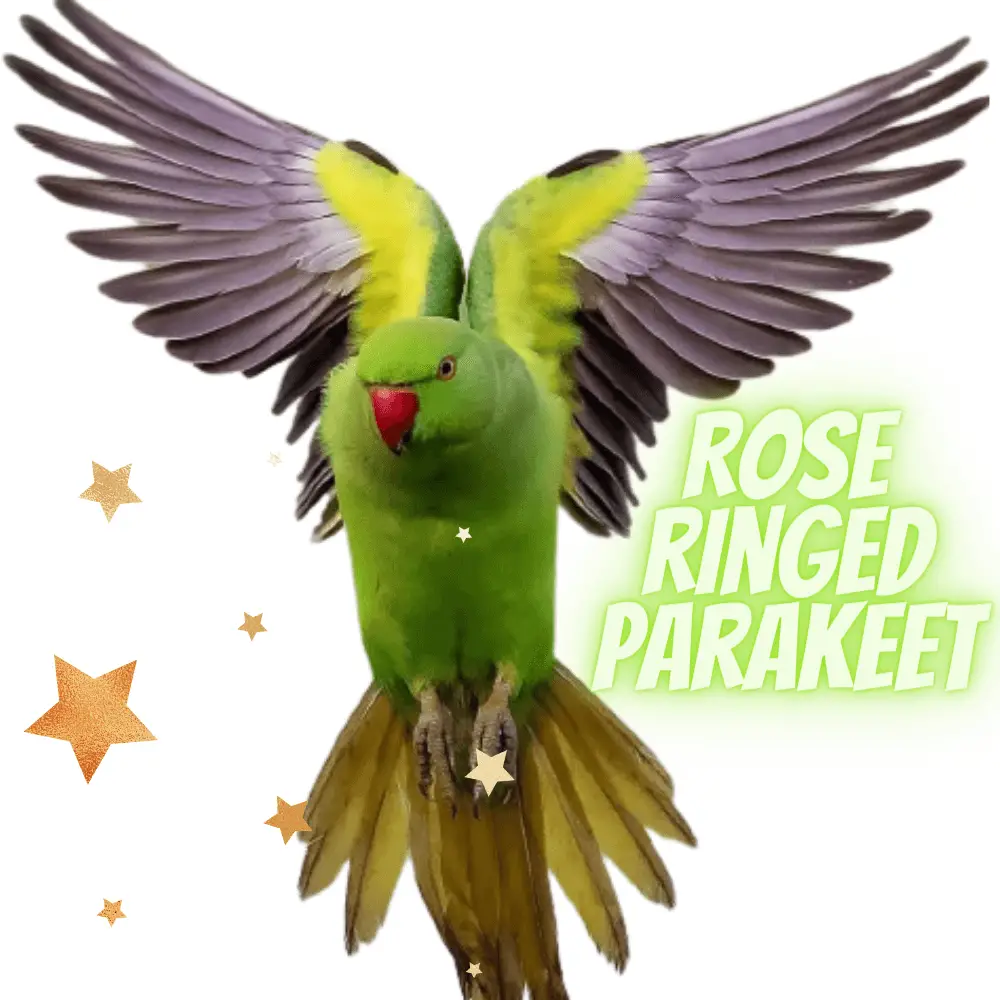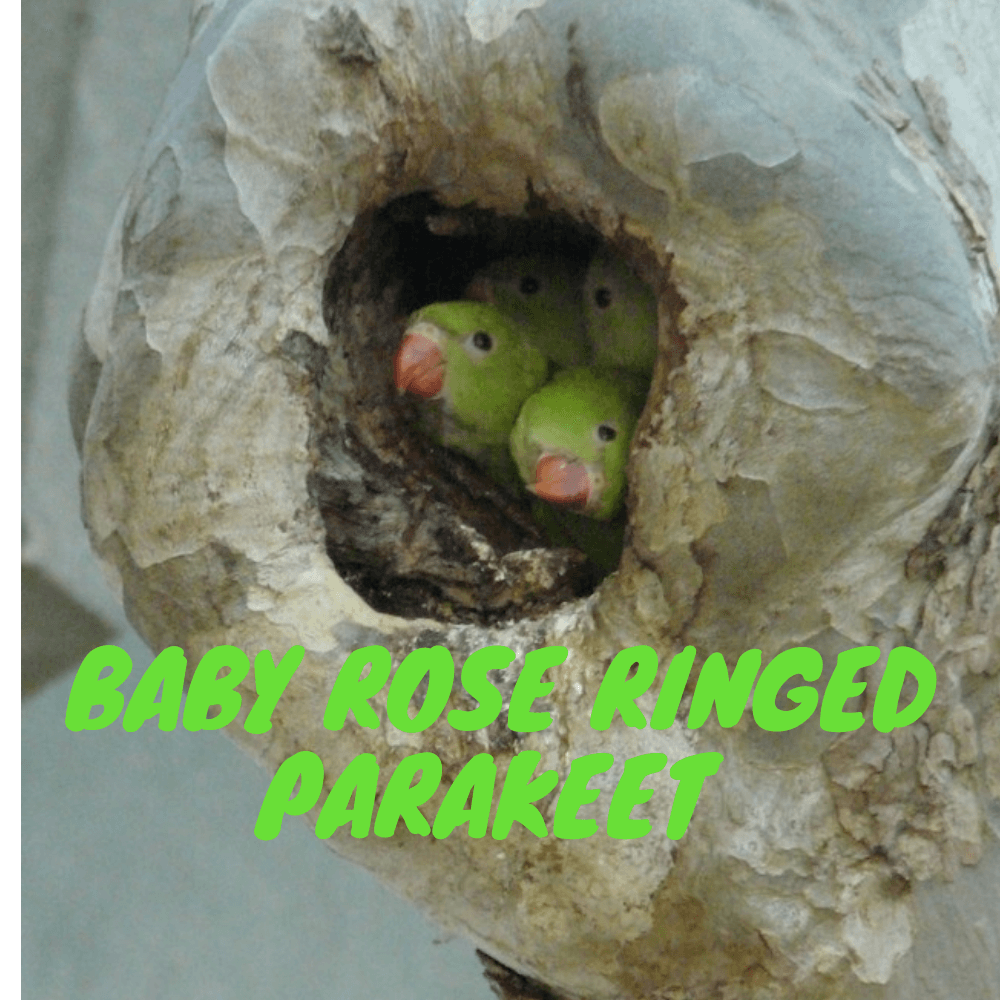
The Rose ringed Parakeet or Ring-necked Parakeet is a slender parakeet, 40th of a cm in length, half of which is for the tail. It displays plumage in shades of green and yellow on the warm parts of the body.
The bill is red, with a black lower mandible in the type subspecies. The eye is yellow circled in red. The flight feathers are darker green above. In the lower view, the wing shows a clear contrast between the blackish flight feathers and the green coverts.
The central rectrices are blue in the breeding adult. A dimorphism sexual expression is expressed in the head and neck. The male is distinguished from the female by his black throat extending to the sides of the neck in a thin collar outlined in pink.
The female does not have it. There are several subspecies that are distinguished only by minor variations in color. For example, the Asian subspecies Borealis has an all-red bill, while the typical ssp has it red and black.
Identification
37–43 cm; 95–143 g. Pale yellowish-green, with upper mandible dark red-tipped black, lower black, with a black chin and malar area curving and narrowing into half-collar on side of neck, where bordered below by a narrow rose pink line that extends over nape, above by indistinct mauve-blue extending onto hind crown; flight-feathers duskier green above, grey below; tail bluish green on central feathers, cherish below.
Female lacks blue, pink, and black on the head but can show emerald collar. Immature like female but yellower, with no or indistinct collar.
Race parvirostris darker, with stronger pink collar in male, upper mandible all red; borealislarger and more greyish below, with more blue on the head, the bill usually all red; manillensis
Subspecific

Rose ringed Parakeet
Subspecies
Feral in many places, mainly in cities and their environs, in Africa, Arabia, W Palearctic, and W Asia (some of these populations may conceivably be natural);
also Mauritius, Seychelles, Hawaiian Is, Hong Kong, Macao and Singapore, and apparently USA and Venezuela; unclear which races involved, although often attributed to Borealis.
Psittacula krameri krameri Scientific name definitions
P. k. krameri+1
Distribution
Psittacula krameri parvirostris Scientific name definitions
Distribution
Psittacula krameri borealis Scientific name definitions
P. k. borealis+1
Distribution
Psittacula krameri manillensis Scientific name definitions
Distribution
Distribution
Editor’s Note: Additional distribution information for this taxon can be found in the ‘Subspecies’ article above. In the future, we will develop a range-wide distribution article.
Voice singing and shouting
Whether perched in a tree or in flight, Ring- necked Parakeets utter shrill calls like “kii-aa” or “kiy-ak” that do not go unnoticed. Other vocalizations like “kyik-kyik-kyik” are also audible. In captivity, these birds are able to imitate familiar house noises and even articulate a few words.
Behavior character traits
The Ring-necked Parakeet is a gregarious, bold, and opportunistic bird, able to adapt to many situations. It is frequently observed in noisy groups going from place to place in a very fast direct flight.
The groups of adults break up at the time of reproduction which nevertheless has a somewhat colonial character. But the troops reform quickly from the emancipation of young people.
This bird is sedentary, which does not prevent it from making local movements, especially in Africa where it moves slightly north towards Burkina Faso and Mauritania during the rainy season (August to November).
Flight
Theft of ringed Parakeet is a direct and fast flight, even over short distances, provided by the beats of wings fast, regular, and very energetic.
What do rose ringed parakeets eat
The Ring-necked Parakeet is almost exclusively vegetarian. The diet consists of all kinds of fruits, various seeds, buds, flowers, and others, flowers or fleshy leaves, etc.
In Asia, and more particularly in India, this bird is considered a real plague for agriculture because it will feed in large numbers in the fields and fruit trees.
In the urban parks of the European cities it occupies, its impact on ornamental or ornamental woody plants should be assessed and quantified in order to know whether it is really harmful there.
Reproduction nesting
In western Africa and probably also in the Arabian Peninsula where it has undoubtedly been introduced, the Ring-necked Parakeet nests between December and May.
In South Africa, nesting takes place in September in willow woodlands. In Asia, reproduction takes place from January to April and sometimes in July. In the United Kingdom, the feral population breeds from January to June.Ring-necked Parakeets nest in loose colonies.
The laying usually consists of 3 or 4 eggs which are incubated for 22 or 23 days.
The nestlings stay in the nest for about 7 weeks. Breeding in Nigeria is often unsuccessful due to Calaos in red beak (Tockus erythrorhynchus) which are aggressive and likely covet the same cavities.

Rose ringed Parakeet
Rose ringed parakeet price
Rose ringed parakeet or Ring-necked Parakeet Pricing ranges from $400 to $500,and you can expect to pay up to $750 depending on the bird and the Breeder organizations
Distribution
The Ring-necked Parakeet is naturally distributed over the tropics of the old world. In Africa, its distribution area extends from Mauritania and Senegal to the Red Sea in a fairly wide sub-Saharan strip.
In Asia, it mainly occupies the Indian subcontinent, but the area spills over into Pakistan to the west, southern China, and Burma to the east.
There are officially 4 subspecies :
P. k. krameri (Africa, from southern Mauritania and Senegal to Uganda and southern Sudan) – P. k. parvirostris (Africa, central-eastern Sudan to Djibouti and north-western Somalia via Eritrea and Ethiopia)
– P. k. Borealis (Asia, northwestern Pakistan, northern India, Nepal, northern Myanmar, and southeastern China (Guangdong) – P. k. manillensis (Asia, Indian subcontinent south of the 20th degree North latitude and Sri Lanka).
Many feral populations, resulting from captivity or introduced, are today present almost everywhere in the world, in Africa, in Arabia, in Europe, in the west of Asia as well as in Mauritius, Hong Kong, Macao, Singapore, and even in the United States.
Threats – protection
This species is not threatened. In its natural habitat and in most regions where it has been introduced, it is even relatively abundant. Its adaptability to humans and their activities is at the origin of its demographic and spatial increase.
This bird has a bad reputation locally for the damage it causes, including in areas where it has been introduced.
On the other hand, in an urban context, it enjoys a rather good image, despite its discordant cries. It is beautiful to see and comes to eat almost in the hand the food which is made available to the birds.
Iconography
Systematics History
Editor’s Note: This article requires further editing work to merge existing content into the appropriate Subspecies sections. Please bear with us while this update takes place.
In the past was sometimes considered conspecific with P. eques. Proposed race centralis (probably from Sudan) included within nominate; fragosa (from Rajasthan, W India) is a synonym of Borealis. Four subspecies recognized.
Rose ringed parakeet lifespan
The rose-ringed parakeet or Ring-necked Parakeet lifespan ranges between 25-30 years. In captivity, the are able to live a longer life
Habitat
Ring-necked parakeets frequent a wide variety of tree habitats ranging from semi-deserts to fairly clear jungles, since they present cavities for reproduction, most often trees with holes, but not only.
It has a clear preference for deciduous woods.
They are mainly found in low-lying areas, but in Asia, they can climb up to 1,600 meters above sea level. In Africa, it rises higher, for example up to 2000 m in Ethiopia.
On the other hand, in Europe, the feral populations resulting from captivity are essentially urban and reproduce in “park” type woodlands.
Chiefly deciduous habitats ranging from semi-desert to light secondary jungle, mainly in lowlands but ranging in Asia up to 1600 m and in Ethiopia to c. 2000 m.
Short-grass and semi-desert savanna, open scrub and bushland, wooded valleys, savanna woodland, riparian and evergreen forest, foothill pine zone in Pinus roxburghii, open agricultural land with scattered trees, gardens, orchards, cultivations, often also grain yards at entrepots and railway stations.
Movement
Resident, but subject to minor local movements in Africa, e.g. recorded throughout the year in Ouagadougou, Burkina Faso, except Jun, and a rainy season visitor (Aug–Nov) to parts of S Mauritania. Also irregular in Ghana and one part of the Central African Republic.
Diet and Foraging
In Africa, recorded fruits
Sounds and Vocal Behavior
Mainly gives rather high-pitched dry screeches, often in fast series, e.g. “kreeh-kreeh-kreeh-kreeh…”. Groups can be very noisy. When perched, the repertoire also includes squeaky notes, piercing whistles, and subdued squabbling calls.
Dec-May in W Africa and probably also Arabian Peninsula (possibly introduced); in Nigeria, nesting attempted in May, but failed to owe to aggression by Red-billed Hornbills (Tockus erythrorhynchus);
Sept in South Africa, in willow trees over a large pool; Jan–Apr, sometimes to Jul, in Asia; Jan–Jun in the UK (introduced).
Nest in a hollow in a tree, usually enlarged by birds themselves, 3–10 m up, but sometimes in rock faces or ruined walls; often loosely colonial.
Eggs are usually 3–4, rarely six, size (nominate, laid in captivity) 29–31 mm × 21·5–22·1 mm; incubation lasts 22 days; nestling period 7 weeks. In England, clutch size 3∙7 eggs on average (n = 77), nestling period c. 49 days, 72% of nests successful, and 1∙4 young fledged per nest.
Conservation Status
Not globally threatened (Least Concern). CITES III (Ghana). Common to abundant throughout the natural range and in many places where introduced, e.g. Mauritius, and generally increasing in numbers and range, partly through introductions and escapes, partly through the use of spreading agriculture and horticulture. Introduced to but died out from Zanzibar, the loss being attributed to House Crows (Corvus splendens).
Noted as a crop pest at the start of the century, Ghana, and now recognized as such throughout its range, including areas where introduced such as South Africa.
Only fairly common, Myanmar; very rare in a limited range, China. Now common and exponentially increasing in many European cities, including London, Paris, Brussels, The Hague, Cologne, Bonn,
Rome, Barcelona, Madrid, and Lisbon. In the London area, where breeding was first reported in 1970, the population increased at an average annual rate of c. 30% and there were c. 30,000 birds by 2006–2008;
in Brussels, the first breeding was in 1975 and there were more than 10,000 birds in 2008; in Paris (Île-de-France region), the first breeding was in 1980 and there were c. 500 birds in 2006, 1050 birds in 2008, and 5000 birds in 2014.
The success of the establishment seems at least partially due to food being provided at bird-feeders . This species may compete with native cavity-nesting birds, like Eurasian Nuthatch (Sitta europaea) in Brussels , or even with bats, like greater noctule (Nyctalus lasiopterus) in Seville, Spain .





















